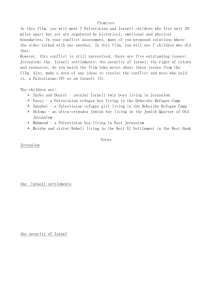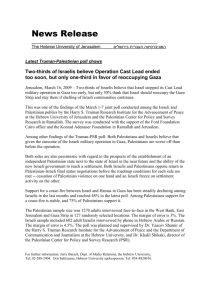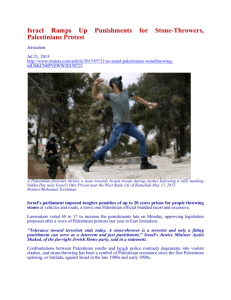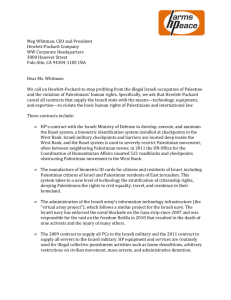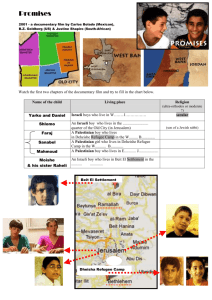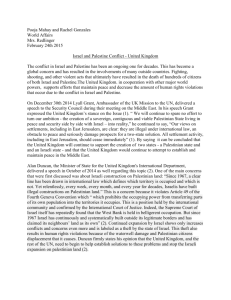Norbert Goldfield - Peace (building) through Health
advertisement
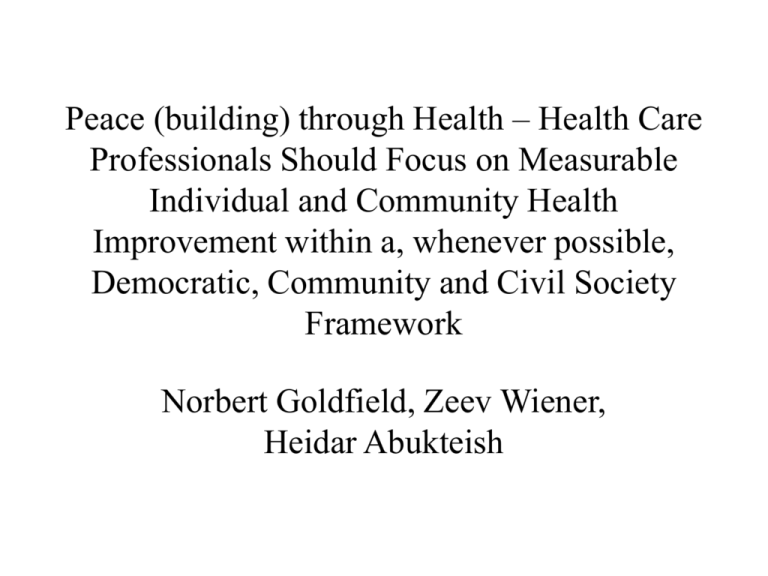
Peace (building) through Health – Health Care Professionals Should Focus on Measurable Individual and Community Health Improvement within a, whenever possible, Democratic, Community and Civil Society Framework Norbert Goldfield, Zeev Wiener, Heidar Abukteish The health of the people is really the foundation upon which all their happiness and all their powers as a state depend Benjamin Disraeli A New Definition of Health by the European Region of the World Health Organization • Health is the extent to which an individual or group is able , on the one hand, to realize aspirations and satisfy need, and, on the other hand, to change and cope with the environment. Health is therefore seen as a resource for everyday life, not the objective of living; it is a positive concept emphasizing social and personal resources as well as physical capacities Diabetes as a case example • Diabetes is the most common chronic illness afflicting Israelis and Palestinians affecting approximately 10% of both populations, a large percentage of whom are poorly controlled. • Diabetes is best controlled (as measured both biochemically and from the subjective perspective of the individual which includes their perception of empowerment/engagement) within a framework individual empowerment in a setting of active community and political support. • Psychosocial and socioeconomic challenges, most notably, settings of conflict significantly exacerbate the ability of individuals to control their diabetes Diabetes (cont) • Interventions aimed at Israeli and Palestinian diabetics must focus on measurable individual improvement while taking into account the political, economic and cultural barriers to improved diabetes control. Diabetes study design • Small groups of people; • Cooperation across the divides – soft measure • Validated outcomes measures – clinical, patient derived and societal impact • If outcomes measure positive rapidly disseminate Characteristics of Orientalism • The Orient is an idea that has a history and a tradition of thought, imagery and vocabulary that have given it "reality." Its reality and stability comes from its status as a geopolitical entity. • The relationship of Occident and Orient is that of power, of domination, and varying degrees of a complex hegemony. Hegemony, according to Gramsci, is the form of cultural dominance over other cultures, formed by consent in civil society, rather than in political society. Difference between PeaceBuilding and Peace Initiatives • Health professionals working in their professional capacity can contribute to peace-building • Peace (through health or any other area) is a political process and requires the intervention of individuals/groups that have political standing Conflict sensitive health interventions can produce lasting benefits even when the general political situation generating conflict is not easily solved. Peace-Building Through Health: Potential Roles of Health Professionals Israeli and Palestinian health care professionals not infrequently make the “jump” into being politicians. These individuals can actively contribute to the peace process via the political parties they are members. Communication of Knowledge • One can assist with Communication of Knowledge, thereby putting a human face on suffering, and this information may be considered the most credible, unbiased sources of information. Such organizations may be seen as impartial, uniquely treating people of all sides without prejudice. Healing of the Individual and Society; Strengthening of Communities • By their very presence, as one institution persisting throughout a conflict, they can develop, foster, or sustain a structure for post-conflict rebuilding. Though not their primary objective, they can also help with Healing of the Individual and Society (physical, psychological and at times even spiritual), and Strengthening of Communities. Extend Solidarity • Medical professionals can Extend Solidarity merely by their presence; that is, by risking their own lives to treat people in war zones. Such gestures can give hope to the relatively powerless side of a conflict, strengthening their struggle for fundamental human rights. Broaden the Concept of Altruism • Medical personnel may Broaden the Concept of Altruism, treating victims impartially in a war zone when military and other civilian personnel are propagandised into believing that people on the opposite side of a conflict have and deserve fewer rights as they are different. Personalize the Enemy • On a larger scale they may personalize the Enemy, opposing war leaders who seek to diminish, depersonalize, and dehumanize the ‘enemy’. Professional and personal connections with patients and colleagues throughout the world make the concepts of ‘enemy’, ‘foreigner’, or ‘out-group’ people seem bizarre. Non-co-operation and Dissent • Non-co-operation and Dissent describes the refusal of medical personnel to participate in what are considered unjust war campaigns of their governments, such as Israel in the Occupied Territories, the US in Vietnam and Iraq, or Russia in Chechnya, or to oppose weapons systems such as nuclear weapons. Diplomacy • Bolstered by the legitimacy conferred by the Nobel Peace Prize, prestigious medical organizations such as the ICRC, IPPNW and MSF are able to engage in Diplomacy. IPPNW had contacts with the highest level of Soviet administration and with various members of the US Congress and administration. No less a personality than Mikhail Gorbachev credited IPPNW with convincing him to push for arms reduction agreements. Critique of the Model • The model presented here has been criticized as being Euro-centric, biomedical, and neglectful of the roles of other professionals and alternative practitioners, or dismissive of the role of other non-health professionals. It also appears to limit discussion to the roles of outsiders in a conflict. Indeed, although evidence may be found for all of these charges, the intention of the model is not to be a static, comprehensive model for peace, but to explore ways for those outside immediate zones of ‘hot’ conflict to contribute Health indicators: • Infant mortality; population mortality • Deaths and injuries caused by weapons of war • Nutritional status • Communicable diseases Political indicators: • - level of public political participation • - multi-communal political parties; fair and free elections • - political representation • - emergency rule in parts or all of a country • - freedom of movement • - the right not to be deprived of one’s nationality or to be exiled PTSD IN ISRAELI CHILDREN 100% 80% 60% 40% 40% 28% 27% 16% 20% 0% Jerusalem Katif Data: Gallili-Vistov, HMC Jerusalem. Lavi, TAU, 2002. Efrat Gilo ISRAEL'S SOCIAL STATUS 1 2 3 4 5 6 7 8 9 10 11 12 13 14 15 16 17 18 19 20 21 22 23 24 25 1990 Finland Denmark Sweden Canada Norway Hungary Czech Rep Switzerland Austria Germany USA Netherlands Australia Japan Belgium France UK Poland New Zealand ltaly Portugal Israel Spain Korea, Rep lreland 104 103 103 103 102 102 101 101 101 100 100 100 100 99 99 98 98 97 97 96 95 94 94 93 91 1 2 3 4 5 6 7 8 9 10 11 12 13 14 15 16 17 18 19 20 21 22 23 24 25 1996 Finland Sweden Norway Denmark Netherlands Switzerland Canada Austria Australia Germany Czech Rep Hungary USA Japan France UK Belgium New Zealand Poland Israel Korea, Rep lreland Portugal Spain ltaly 103.9 103.2 103.1 102.9 101.8 101.6 100.9 100.4 100.2 99.9 99.8 99.7 99.7 99.3 99.1 99.0 98.7 98.0 95.4 94.7 94.6 94.3 94.1 93.8 93.6 1 2 3 4 5 6 7 8 9 10 11 12 13 14 15 16 17 18 19 20 21 22 23 24 25 2002 Finland Norway Denmark Netherlands Sweden Switzerland Austria Canada Hungary Australia USA Germany Czech Rep France UK Japan New Zealand Belgium lreland Portugal Poland Spain Korea, Rep Israel ltaly 104.0 103.9 103.4 103.2 103.2 102.1 101.2 101.2 101.0 100.2 100.0 100.0 99.8 99.7 99.5 98.7 98.5 98.4 96.7 96.5 95.9 95.8 95.6 94.6 94.4 ISRAEL'S STATE OF MIND (2) % PROUD OF THE STATE 100 90 80 70 WANT TO LIVE IN ISRAEL 60 50 SEP 99 APR 00 FEB 01 APR 03 NOV 03 % 90 80 70 60 50 40 30 20 10 0 FEB 98 JAN 99 JAN 00 APR 01 FEB 02 APR 03 NOV 03 PERCEIVED RESILIENCE AND WILLINGNESS TO SACRIFICE: TEL-AVIV vs TERRITORIES YOUTH Perc. Resil past Perc. Resil today Sacrif past Sacrif today 2.5 2.45 2.4 2.35 2.3 2.25 2.2 2.15 2.1 2.05 Tel-Aviv Territories Laor n, Wolmer L. 2002. Unpublished Data. The term structural violence has been used to designate people who experience violence (and violation) owing to extreme poverty. That violence includes the high rates of disease and death, unemployment, homelessness, lack of education, powerlessness, a shared fate of misery, and day-by-day violence of hunger, thirst, and bodily pain It costs approximately $100 to give a box of fortified milk and a fortified wafer to one child every school day during the nine month school year. Thus, this program will cost about $1.3 million for 13,000 children during the 2004-2005 school year. After disengagement, will basic provisions still be imported from Israel? To date, according to businessmen and government officials, there are no negotiations or discussions on this very essential Palestinian need. And as the above noted statistics on containers moving from Israel to Gaza indicate, Gaza is highly dependent on Israel for most of its basic supplies. Economy Unemployment 2000 2004 Total 10% 28.6% West Bank 7.5% 23.6% Gaza Strip 15.5% 39.7% Healing Across the Divides Executive Director Norbert Goldfield, M.D. The mission of Healing Across the Divides, an American organization, is to assist Israeli/ Palestinian health care organizations to improve the health of Israelis and Palestinians via increased health professional mediated health and human rights improvements and policymaker decisions. Healing Across the Divides • While many are convinced that the peace process is today on life support, many Israeli and Palestinian health professionals believe that one option is to concentrate on improving the health status of both populations via cooperation between Israeli and Palestinian health care organizations. If these initiatives are successful and receive attention both in and outside the Middle East, health professionals hope that they can contribute at the appropriate time to a reawakening of a serious commitment to peace. Israeli and Palestinian health care professionals (and American and European health professionals interested in Israeli/Palestinian peace building) work on peace (building) in two ways a. as a by-product of activities that focus on individual health improvement/ maximizing human dignity/autonomy within a,hopefully, democratic organizational framework. b. as a by-product of activities that focus on community wide health improvement that acknowledge the social determinants of health Healing Across the Divides • The idea for this new organization emanates from a successful U.S. “tour” that Israeli and Palestinian physicians undertook in March 2004 in which they spoke of the promise and challenge of already existing cooperation “across the divides”. Divide is framed in the plural to recognize that this organization will not only focus on the divide between Israelis and Palestinians but also the divides that exist within Israeli and within Palestinian societies. Speaking engagements included: • Joint session Harvard University School of Public Health and Medicine, Boston, MA • Carter Center, Atlanta, GA • American Task Force on Palestine, Washington, DC • American Jewish Committee,Boston+ NYC • State Department It is important for Israeli and Palestinian health professionals with the assistance of outside professionals from outside the Middle East to identify: concrete health and ethical problems, research questions that are significant, need resolution, and are resolvable by the parties coming to the meeting and join forces to form a common strategy to tackle the problems. Under the guidance of a Board of Directors and Board of Scientific Advisors, Healing Across the Divides will pursue initiatives that will result in: • Documented improved health status of the population served • Increased clinical knowledge base for both Palestinian and Israeli health professionals but particularly the former • Increased knowledge base and exchange of ideas on issues pertaining to violence and its prevention particularly for health professionals and health care students. Initiatives (cont) • Enhanced awareness of health and human rights as it pertains to health professionals in the light of the current conflict. • Increased awareness, on the part of policymakers and other interested parties, of the obstacles to improvement in the health of both populations. Board of Directors as of January 2005 • Heidar Abu Kteish, MPH, Director of Prevention Programs, Union of Palestinian Medical Relief Committee, Ramallah, Palestine • Ziad Asali, M.D., Executive Director, American Task Force on Palestine, Washington DC • Paul Hassoun, M.D. Johns Hopkins University School of Medicine, Baltimore, MD • Alfred Khoury, M.D., Chair, Medical Committee, ANERA (American Near East Refugee Aid), Washington DC Board of Directors (cont) • Larry Lowenthal, PhD, Executive Director, American Jewish Committee, Boston Chapter, Boston, MA • Margaret O Kane, MPH, President, National Committee for Quality Assurance, Washington, DC • Leonard Rubenstein, J.D. Executive Director, Physicians for Human Rights – USA, Washington, DC • Hadas Ziv, Executive Director, Physicians for Human Rights – Israel, Tel Aviv Israel International Committee of Expert Scientific Advisors Examples of projects we will pursue beginning in 2005 include joint: • Initiative to improve health status of diabetics and hypertensives • Training program to enhance medical ethics among health professionals. • Course on Peace-Building Through Health at an American college, Spring 2005 By improving the health of Palestinians and Israelis we are attempting to accomplish this via a human rights lens and thus enhance the dignity of each human being impacted by these programs. Initial Project Partners • Union of Palestinian Medical Relief Committees • Physicians for Human Rights – Israel. • The Galilee Society Examples of potential roles for Palestinian/Israeli academic institutions • Assist in identification of appropriate projects – prevalence of chronic illnesses among Palestinians. Ongoing study (?) at Al Quds on prevalence of chronic illnesses • Assist/ direct evaluation of initiatives • Assist in ongoing evaluation/ critique of project models. Financing for Healing Across the Divides • $100,000 in initial funding • Cost of pilot diabetes projects (approximately 100 Palestinian and Israeli individuals) will be modest • If medication/glucose monitoring equipment is available free of charge (donation etc) the cost of providing care from a community health perspective to 1000 Palestinians will be approximately $10000. • Additional monies as needed will be applied for from private individuals and government grants. I have pessimism of the intellect, optimism of the will – Gramsci, 1920’s To move even slightly from pessimism of the intellect to optimism of the will we need to successfully implement at least one project on a small scale that measurably improves the health of both Palestinians and Israelis.


